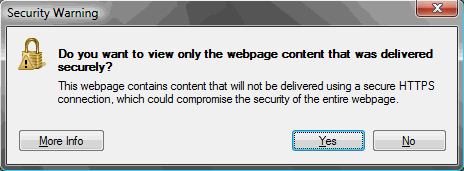What is SSL, HTTP & HTTPS, and what does it mean to Google?
SSL is the acronym for Secure Socket Layer. An SSL certificate for your page will encrypt and secure the transfer of data - such as client details.
HTTP is the acronym for Hypertext Transfer Protocol, and HTTP is – you guessed it - Hypertext Transfer Protocol Secure. Essentially, once you have an SSL certificate for your web page, it changes from a HTTP, to a HTTPS.
In 2014, Google announced their vision for a utopian future – that every site on the web will use HTTPS. They have three main reasons for this push- “Authentication,” “Data Integrity,” and “Encryption. Simply put, Google is trying to make the web safer – for businesses as well as their customers.
So why not just get an SSL certificate for your checkout?
Well, there are a few problems that can be associated with having ‘mixed content’ - both secure & insecure content or pages.
Mixed Content Warnings
So let’s say you already have an SSL certificate for a page in your website, for example the checkout, but not all pages of your site are SSL. This is when you can run into these pesky things called Mixed Content Warnings. Long story short – these warnings are a nightmare for keeping traffic on your site.
For many people, the moment they see any some sort of warning on the web they simply leave the site - and rarely return. So although mixed content warnings don’t have a direct impact on your SEO as Google has confirmed, they can still have a negative impact on your website, and your business as a result. PLUS, if you take into account the ‘Bounce Rates’ associated with people leaving your site due to these warnings, there is still an indirect effect on your Google ranking.

Other technical problems associated with mixed HTTP & HTTPS.
Having a mixture of HTTP & HTTPS pages on your site can also cause other technical issues, aside from the mixed content warnings.
For example, one of our client’s recently discovered that although their ‘checkout’ was a secure page, because other pages had unsecure content added, customers were being automatically logged out of the site before they could reach the end checkout.
Although this demonstrates exactly how secure this website really was – with added safety precautions, it of course meant lost business.
This example highlights just how important it is, not only to ensure your pages all have an SSL, but also to ensure you are not adding unsecure content to these pages.
So how do I make the change from HTTP to HTTPS?
There are of course, difficulties that you may come up against in trying to move your site from HTTP to HTTPS, especially older, more established sites.
Redirecting issues, of course mixed content problems, and duplicate content – each of which can affect not only your Google ranking, but also your overall user experience.
The best way to navigate your way through converting from HTTP to HTTPS is to consult the professionals. The possible negative results of an incomplete or incorrect conversion are far too much to risk, especially when it comes to the health of your website, and your business.
If you’d like to know more about SSL, Google, SEO, or anything else related to all things online, give the Digital Marketing team at Clue Design a call on 9368 0777 today